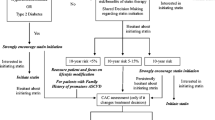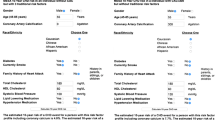Abstract
The importance of screening for subclinical coronary artery disease is reinforced by the detection gap existing between the currently used risk stratification tools and the persistently elevated rates of cardiovascular disease in Western countries. Medicare data clearly indicate the extremely high cost of caring for patients with end-stage diseases, and early detection may curb some of these expenses. Coronary artery calcium screening has become a widely used tool to estimate risk in a variety of categories in the general population and is discussed in this review.
Similar content being viewed by others
References and Recommended Reading
Mark DB, Shaw LJ, Lauer MS, et al.: Is atherosclerotic imaging cost effective? J Am Coll Cardiol 2003, 41:1906–1917.
Goldman L, Garber AM, Grover SA, Hlatky MA: 27th Bethesda Conference: matching the intensity of risk factor management with the hazard for CAD events. Task Force 6. Cost effectiveness of assessment and management of risk factors. J Am Coll Cardiol 1996, 27:1020–1030.
Russell LB, Gold MR, Siegel JE, et al.: The role of cost-effectiveness analysis in health and medicine. Panel on cost-effectiveness in health and medicine. JAMA 1996, 276:1172–1177.
Weinstein MC, Stason WB: Cost-effectiveness of interventions to prevent or treat coronary heart disease. Annu Rev Public Health 1985, 6:41–63.
Shaw LJ, Redberg RF: From clinical trials to public health policy: the path from imaging to screening. Am J Cardiol 2001, 88(2-A):62E–65E.
Greenland P, Smith SC Jr, Grundy SM: Improving coronary heart disease risk assessment in asymptomatic people: role of traditional risk factors and noninvasive cardiovascular tests. Circulation 2001, 104:1863–1867.
Grundy SM, Pasternak R, Greenland P, et al.: Assessment of cardiovascular risk by use of multiple-risk-factor assessment equations: a statement for healthcare professionals from the American Heart Association and the American College of Cardiology. Circulation 1999, 100:1481–1492.
Wilson PW, D’Agostino RB, Levy D, et al.: Prediction of coronary heart disease using risk factor categories. Circulation 1998, 97:1837–1847.
O’Rourke RA, Brundage BH, Froelicher VF, et al.: American College of Cardiology/American Heart Association Expert Consensus Document on Electron Beam Computed Tomography for the Diagnosis of Coronary Artery Disease (Committee on Electron Beam Computed Tomography). Circulation 2000, 102:126–140.
Redberg RF, Vogel RA, Criqui MH, et al.: 34th Bethesda Conference: Task force #3—What is the spectrum of current and emerging techniques for the noninvasive measurement of atherosclerosis? J Am Coll Cardiol 2003, 41:1886–1898.
Executive Summary of The Third Report of The National Cholesterol Education Program (NCEP) Expert Panel on Detection, Evaluation, And Treatment of High Blood Cholesterol In Adults (Adult Treatment Panel III) [no authors listed]. JAMA 2001, 285:2486–2497.
Nasir K, Redberg RF, Budoff MJ, et al.: Utility of stress testing and coronary calcification measurement for detection of coronary artery disease in women. Arch Intern Med 2004, 164:1610–1620.
Pasternak RC, Abrams J, Greenland P, et al.: 34th Bethesda Conference: Task force #1—Identification of coronary heart disease risk: is there a detection gap? J Am Coll Cardiol 2003, 41:1863–1874.
Blumenthal RS, Becker DM, Yanek LR, et al.: Detecting occult coronary disease in a high-risk asymptomatic population. Circulation 2003, 107:702–707.
Smith SC Jr, Blair SN, Bonow RO, et al.: AHA/ACC Guidelines for preventing heart attack and death in patients with atherosclerotic cardiovascular disease: 2001 update. A statement for healthcare professionals from the American Heart Association and the American College of Cardiology. J Am Coll Cardiol 2001, 38:1581–1583.
Office of the Actuary, National Health Statistics Group: Health Spending Projections Through 2016: Modest Changes Obscure Part D’s Impact. Available at http://content.healthaffairs.org/cgi/reprint/hlthaff.26.2.w242.pdf. Accessed March 2, 2005.
Huang H, Virmani R, Younis H, et al.: The impact of calcification on the biomechanical stability of atherosclerotic plaques. Circulation 2001, 103:1051–1056.
Rumberger JA, Sheedy PF 3rd, Breen JF, Schwartz RS: coronary calcium, as determined by electron beam computed tomography, and coronary disease on arteriogram. Circulation 1995, 91:1363–1367.
Beckman JA, Ganz J, Creager MA, et al.: Relationship of clinical presentation and calcification of culprit coronary artery stenoses. Arterioscler Thromb Vasc Biol 2001, 21:1618–1622.
Fitzgerald PJ, Ports TA, Yock PG: Contribution of localized calcium deposits to dissection after angioplasty. An observational study using intravascular ultrasound. Circulation 1992, 86:64–70.
Veress AI, Cornhill JF, Herderick EE, Thomas JD: Age-related development of atherosclerotic plaque stress: a population-based finite-element analysis. Coron Artery Dis 1998, 9:13–19.
Wayhs R, Zelinger A, Raggi P: High coronary artery calcium scores pose an extremely elevated risk for hard events. J Am Coll Cardiol 2002, 39:225–230.
Arad Y, Spadaro LA, Goodman K, et al.: Predictive value of electron beam computed tomography of the coronary arteries. 19 month follow-up of 1173 asymptomatic subject. Circulation 1996, 93:1951–1953.
Arad Y, Spadaro LA, Goodman K, et al.: Prediction of coronary events with electron beam computed tomography. J Am Coll Cardiol 2000, 36:1253–1260.
Wong ND, Hsu JC, Detrano RC, et al.: Coronary artery calcium evaluation by electron beam computed tomography and its relation to new cardiovascular events. Am J Cardiol 2000, 86:495–498.
Vliegenthart R, Oudkerk M, Song B, et al.: Coronary calcification detected by electron-beam computed tomography and myocardial infarction. The Rotterdam Coronary Calcification Study. Eur Heart J 2002, 23:1596–1603.
Kondos GT, Hoff JA, Sevrukov A, et al.: Electron-beam tomography coronary artery calcium and cardiac events: a 37-month follow-up of 5635 initially asymptomatic low-to intermediate-risk adults. Circulation 2003, 107:2571–2576.
Detrano RC, Wong ND, Doherty TM, et al.: Coronary calcium does not accurately predict near-term future coronary events in high-risk adults. Circulation 1999, 99:2633–2638.
Raggi P, Cooil B, Callister TQ: Use of electron beam tomography data to develop models for prediction of hard coronary events. Am Heart J 2001, 141:375–382.
Shaw LJ, Raggi P, Schisterman E, et al.: Prognostic value of cardiac risk factors and coronary artery calcium screening for all cause mortality. Radiology 2003, 228:826–833.
Greenland P, LaBree L, Azen SP, et al.: Coronary artery calcium score combined with Framingham score for risk prediction in asymptomatic individuals. JAMA 2004, 291:210–215.
O’Malley PG, Taylor AJ, Jackson JL, et al.: Prognostic value of coronary electron-beam computed tomography for coronary heart disease events in asymptomatic populations. Am J Cardiol 2000, 85:945–948.
Pletcher MJ, Tice JA, Pignone M, Browner WS: Using the coronary artery calcium score to predict coronary heart disease events: a systematic review and meta-analysis. Arch Intern Med 2004, 164:1266–1268.
Raggi P, Shaw LJ, Berman DS, Callister TQ: Prognostic value of coronary artery calcium screening in subjects with and without diabetes. J Am Coll Cardiol 2004, 43:1663–1669.
Margolis JR, Chen JT, Kong Y, et al.: The diagnostic and prognostic significance of coronary artery calcification: a report of 800 cases. Radiology 1980, 137:609–616.
Detrano R, Hsiai T, Wang S, et al.: Prognostic value of coronary calcification and angiographic stenoses in patients undergoing coronary angiography. J Am Coll Cardiol 1996, 27:285–290.
Keelan PC, Bielak LF, Ashai K, et al.: Long-term prognostic value of coronary calcification detected by electron-beam computed tomography in patients undergoing coronary angiography. Circulation 2001, 104:412–417.
Möhlenkamp S, Lehmann N, Schmermund A, et al.: Prognostic value of extensive coronary calcium quantities in symptomatic males—a 5-year follow-up study. Eur Heart J 2003, 24:845–854.
Schmermund A, Stang A, Mohlenkamp S, et al.: Prognostic value of electron-beam computed tomography-derived coronary calcium scores compared with clinical parameters in patients evaluated for coronary artery disease. Prognostic value of EBCT in symptomatic patients. Z Kardiol 2004, 93:696–705.
Laudon DA, Vukov LF, Breen JF, et al.: Use of electron beam computed tomography in the evaluation of chest pain patients in the emergency department. Ann Emerg Med 1999, 33:15–21.
Georgiou D, Budoff MJ, Kaufer E, et al.: Screening patients with chest pain in the emergency department using electron beam computed tomography: a follow-up study. J Am Coll Cardiol 2001, 38:105–110.
McLaughlin VV, Balogh T, Rich S: Utility of electron beam computed tomography to stratify patients presenting to the emergency room with chest pain. Am J Cardiol 1999, 84:327–328.
Raggi P, Berman DS: Computed tomography coronary calcium screening and myocardial perfusion imaging. J Nucl Cardiol 2005, 12:96–103.
Blumenthal RS, Becker DM, Moy TF, et al.: Exercise thallium tomography predicts future clinically manifest coronary heart disease in a high-risk asymptomatic population. Circulation 1996, 93:915–923.
Wong ND, Rozanski A, Gransar H, et al.: Metabolic syndrome and diabetes are associated with an increased likelihood of inducible myocardial ischemia among patients with subclinical atherosclerosis. Diabetes Care 2005, 28:1445–1450.
Anand DV, Lim E, Hopkins D, et al.: Risk stratification in uncomplicated type 2 diabetes: prospective evaluation of the combined use of coronary artery calcium imaging and selective myocardial perfusion scintigraphy. Eur Heart J 2006, 27:713–721.
Rozanski A, Gransar H, Wong ND, et al.: Use of coronary calcium scanning for predicting inducible myocardial ischemia: influence of patients’ clinical presentation. J Nucl Cardiol 2007, 14:669–679.
Rozanski A, Gransar H, Wong ND, et al.: Clinical outcomes after both coronary calcium scanning and exercise myocardial perfusion scintigraphy. J Am Coll Cardiol 2007, 49:1352–1361.
Ramakrishna G, Breen JF, Mulvagh SL, et al.: Relationship between coronary artery calcification detected by electron beam computed tomography and abnormal stress echocardiography. J Am Coll Cardiol 2006, 48:2125–2131.
Shaw LJ, Berman DS, Bax JJ, et al.: Computed tomography within nuclear cardiology. J Nucl Cardiol 2005, 12:131–142.
De Backer G, Ambrosioni E, Borch-Johnsen K, et al.: European guidelines on cardiovascular disease prevention in clinical practice. Third Joint Task Force of European and Other Societies on Cardiovascular Disease Prevention in Clinical Practice. Eur Heart J 2003, 24:1601–1610.
Third Report of the National Cholesterol Education Program (NCEP) Expert Panel on Detection, Evaluation, and Treatment of High Blood Cholesterol in Adults (Adult Treatment Panel III) final report [no authors listed]. Circulation 2002, 106:3143–3421.
Smith SC Jr, Greenland P, Grundy SM: Prevention Conference V: Beyond secondary prevention: identifying the high-risk patient for primary prevention: noninvasive tests of atherosclerotic burden: Writing Group III. Circulation 2000, 101:E16–E22.
Budoff MJ, Achenbach S, Blumenthal RS, et al.: Assessment of coronary artery disease by cardiac computed tomography: a scientific statement from the American Heart Association Committee on Cardiovascular Imaging and Intervention, Council on Cardiovascular Radiology and Intervention, and Committee on Cardiac Imaging, Council on Clinical Cardiology. Circulation 2006, 114:1761–1791.
Greenland P, Bonow RO, Brundage BH, et al.: ACCF/AHA 2007 clinical expert consensus document on coronary artery calcium scoring by computed tomography in global cardiovascular risk assessment and in evaluation of patients with chest pain: a report of the American College of Cardiology Foundation Clinical Expert Consensus Task Force (ACCF/AHA Writing Committee to Update the 2000 Expert Consensus Document on Electron Beam Computed Tomography) developed in collaboration with the Society of Atherosclerosis Imaging and Prevention and the Society of Cardiovascular Computed Tomography. J Am Coll Cardiol 2007, 49:378–402.
Author information
Authors and Affiliations
Corresponding author
Rights and permissions
About this article
Cite this article
Raggi, P., Shaw, L.J. Epidemiologic guidance with coronary artery calcium scoring. Curr Cardiol Rep 10, 60–66 (2008). https://doi.org/10.1007/s11886-008-0012-6
Published:
Issue Date:
DOI: https://doi.org/10.1007/s11886-008-0012-6




